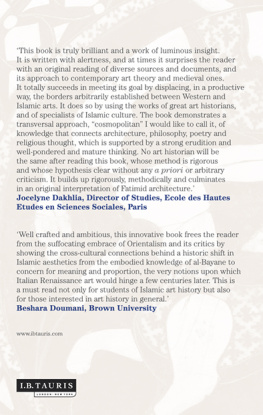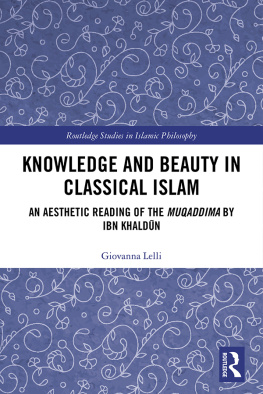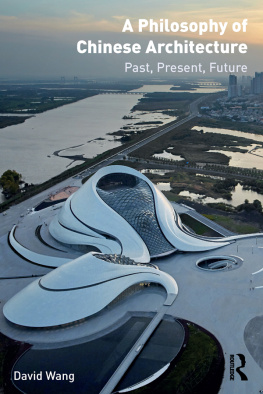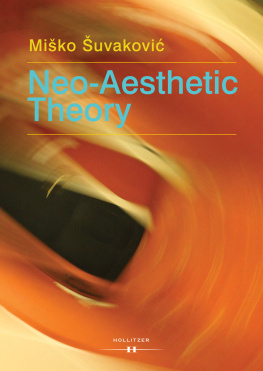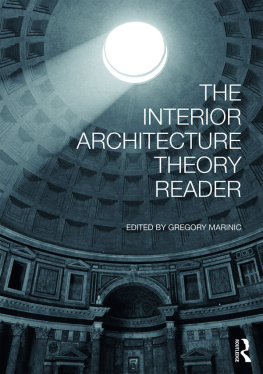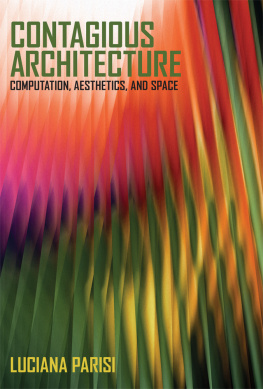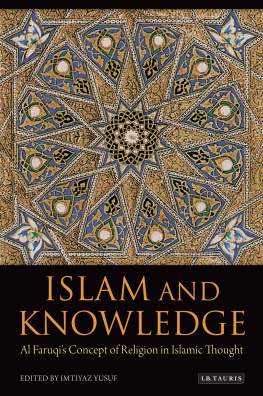
Mohammed Hamdouni Alami is Associate Researcher in the Archaeological Research Facility at the University of California, Berkeley. He was formerly Professor of Architecture and Art History at the Ecole Nationale D'Architecture in Rabat and holds a PhD from the University of California, Berkeley. He is the author of Art and Architecture in the Islamic Tradition: Aesthetics, Politics and Desire in Early Islam (I.B.Tauris, 2010, 2013).
THE ORIGINS
OF VISUAL
CULTURE IN THE
ISLAMIC WORLD
Aesthetics, Art and Architecture
in Early Islam
M OHAMMED H AMDOUNI A LAMI

Published in hardback in 2015 by
I.B.Tauris & Co Ltd
London New York
www.ibtauris.com
Copyright 2015 Mohammed Hamdouni Alami
The right of Mohammed Hamdouni Alami to be identified as the author of this work has been asserted by the author in accordance with the Copyright, Designs and Patents Act 1988.
All rights reserved. Except for brief quotations in a review, this book, or any part thereof, may not be reproduced, stored in or introduced into a retrieval system, or transmitted, in any form or by any means, electronic, mechanical, photocopying, recording or otherwise, without the prior written permission of the publisher.
Every attempt has been made to gain permission for the use of the images in this book. Any omissions will be rectified in future editions.
References to websites were correct at the time of writing.
Library of Middle East History 55
ISBN: 978 1 78453 040 2
eISBN: 978 0 85773 886 8
A full CIP record for this book is available from the British Library
A full CIP record is available from the Library of Congress
Library of Congress Catalog Card Number: available
In memory of my father, and for my mother
CONTENTS
ILLUSTRATIONS
. Tin-glazed ware, monochrome, 18.5 cm, tenth century, from Fustat. Museum of Islamic Art (Photo: Arthur Lane, Early Islamic Pottery, 1965: Pl. 13a)
. Fatimid ware, painted in lustre, from Cairo, early eleventh century. Museum of Islamic Art (Photo: Arthur Lane, Early Islamic Pottery, 1965: Pl. 23b)
. Ceramic Bowl with metallic lustre, 40 cm. From the Museum of Islamic Art, Cairo, Inv. #14923 (by permission of the American University in Cairo Press)
. Youth in a bathhouse. Frescoed architectural fragment from a bathhouse, height: 24.5 cm, width: 60 cm, provenance: Fustat. Museum of Islamic Art, Cairo, Inv.#12880 (by permission of the American University in Cairo Press)
. Fragment of luster pottery held at the Museum of Islamic Art, Cairo (Richard Ettinghausen, Painting in the Early Islamic Period: a Reconstruction, 1942)
. Pottery fragment held at the Museum of Islamic Art, Cairo (Richard Ettinghausen, Painting in the Early Islamic Period: a Reconstruction, 1942)
. Ewer of Al-Aziz billah, rock crystal, European gold mount, height: 18 cm, diameter: 12.5 cm; Tresor of San Marco, Venice, cat. #124 (by permission of the Procuratoria of the Basilic of San Marco, Venice)
. Lion Statuette, cast brass, height: 21 cm, length: 20 cm. Held at the Musuem of Islamic Art, Cairo, Inv. #4305 (by permission of the American University in Cairo Press)
. Ivory Frame, Fatimid Egypt, eleventh to twelfth century. Museum fr Islamische Kunst, Staatliche Museum, Berlin. 30.336.5 cm; frame width 5.8 cm; Inv. #I 6375 (Photo: Georg Niedermeiser; by permission of Art Resource, New York)
. Wooden Panel with a luth musician and two birds, 4021 cm; Museum of Islamic Art, Cairo, #14601 (Photo: Alessandro Vannini)
. Falcon attacking a hare, marquetry, 2241 cm; Museum of Islamic Art, Cairo #3180 (by permission of the American University in Cairo Press)
. Mosque of al-Mahdiyya: plan after A. Lezine
. Mosque of Qayrawan: plan after Creswell
. Mosque of Ibn Tulun: plan after Creswell
. Great Mosque of Samarra: plan after Creswell
. Mosque of ibn Tulun. View of the North Eastern ziyada and minaret
. General plan of al-Mahdiyya (After A. Lezine)
. Mosque of al-Mahdiyya, North Eastern faade
. Mosque of al-Mahdiyya, detail of the North Eastern faade, monumental portal
. Mosque of al-Mahdiyya, an
. Mosque of al-Mahdiyya, central aisle
. Triumphal arch of Pheradi Majus
. Detail of the triumphal arch of Pheradi Majus
. Al-Mahdiyya harbour
. Mosque of Qayrawan, North Eastern faade
. Mosque of al-kim: monumental portal of North Eastern faade
. Mosque of al-kim, an and Minaret
. Mosque of al-kim: plan after Creswell
. Mosque of al-kim: perspective after Creswell
. Mosque of al-Azhar: plan after Creswell
. Mosque of al-kim: view of the prayer hall from an
. Mosque of al-kim: central aisle and qibla niche
. Mosque of al-Azhar: view of the prayer hall from an
. Mosque of al-Azhar: central aisle and qibla niche
. Mosque of al-Azhar: qibla niche
. Al-Aqmar mosque: plan after Creswell
. Al-Aqmar mosque: faade with portal
. Coptic Museum, faade
ARABIC CHARACTERS

ACKNOWLEDGMENTS
This book benefitted from the help, support and suggestions of many friends and colleagues. I would like to thank in particular:
Jocelyne Dakhlia, and Beshara Doumani for their friendship, support, reading and enriching comments on the manuscript.
Sergio Ferro, and Randolph Starn for reading my manuscript and providing me with enriching and insightful comments and suggestions.
Luca DIsanto and Saleem Al-Bahloly, who read chapters of the book and gave me their valuable feedback.
Finbarr Barry Flood, who read and commented on my initial research proposal.
Chris Cochran, who edited the first version of the book.
Cleo Cantone for editing the final version, her friendship, encouraging remarks and suggestions.
Iman Abdulfattah, Patricia Kubala, Anneka Lenssen and Khalid Mosalam for helping me get the digital images from the Museum of Islamic Art of Cairo.
Alami D. Jaouad, Benlamlih Aziz, Beate Fricke, Yazid H. Alami, Kadiri Jaouad, Laura Nader, Christofer Polk, Sebti Abdelahad and Soraya Tlatli for their friendly encouragement.
Stefania Pandolfo and Yassine, my son, for their unwavering support and critical intellectual engagement.
My editor Maria Marsh for her constant support.
This work benefitted, at its initial stage, of a seed grant from the Al-Falah Program of the Center for Middle Eastern Studies, University of California at Berkeley.
CHAPTER 1
INTRODUCTION
Know that differences in opinion and method among scholars bear many benefits that remain hidden [even] to most of the wise people That is why it is said: difference amongst scholars is a Mercy.
From La Dolce Vita to Intellectual Delectation
Know, oh brother, may God support you and us with a spirit from Him, that when a sperm drop escapes from all harms in the uterus the new born will be healthy, and his body structure will be perfect (tmmatu al-ra). His height is eight of his own handspans: two handspans from the top of the knee to the sole of the foot; two handspans from the top of the knee to the top of the waist; two handspans from the top of the waist to the top of the heart; and two handspans from the top of the heart to the top of the head. If the baby opens his hands and extends his arms to the right, and to the left, as birds open their wings, the distance from his right fingertips to the left ones is eight handspans: the midpoint of that is the top of the sternum, and the fourthpoint is the elbow. When he extends his arms upward and the sharp edge of a compass is put on his belly button and the compass is open up to his fingertips and rotated towards his toenails the total length from his fingertips to his toenails is ten handspans, which is a quarter more than his height.
Next page
